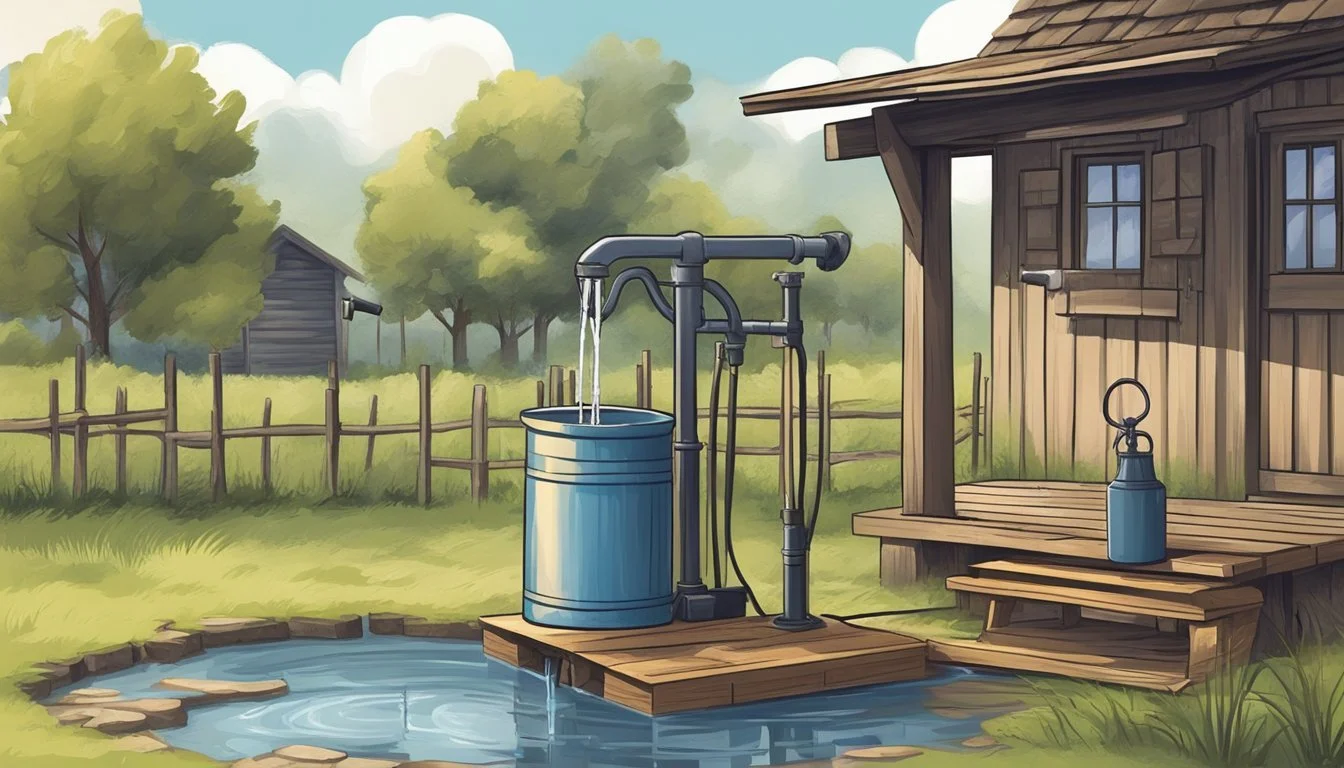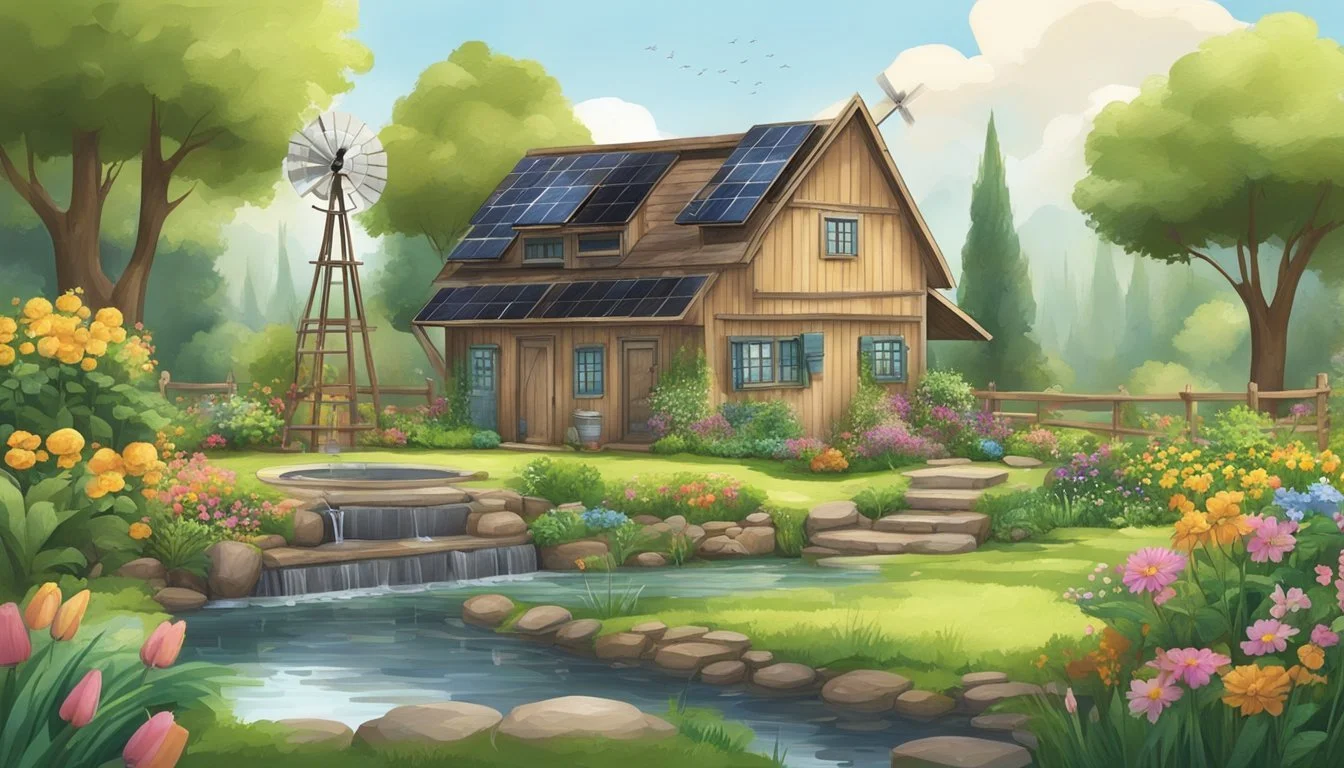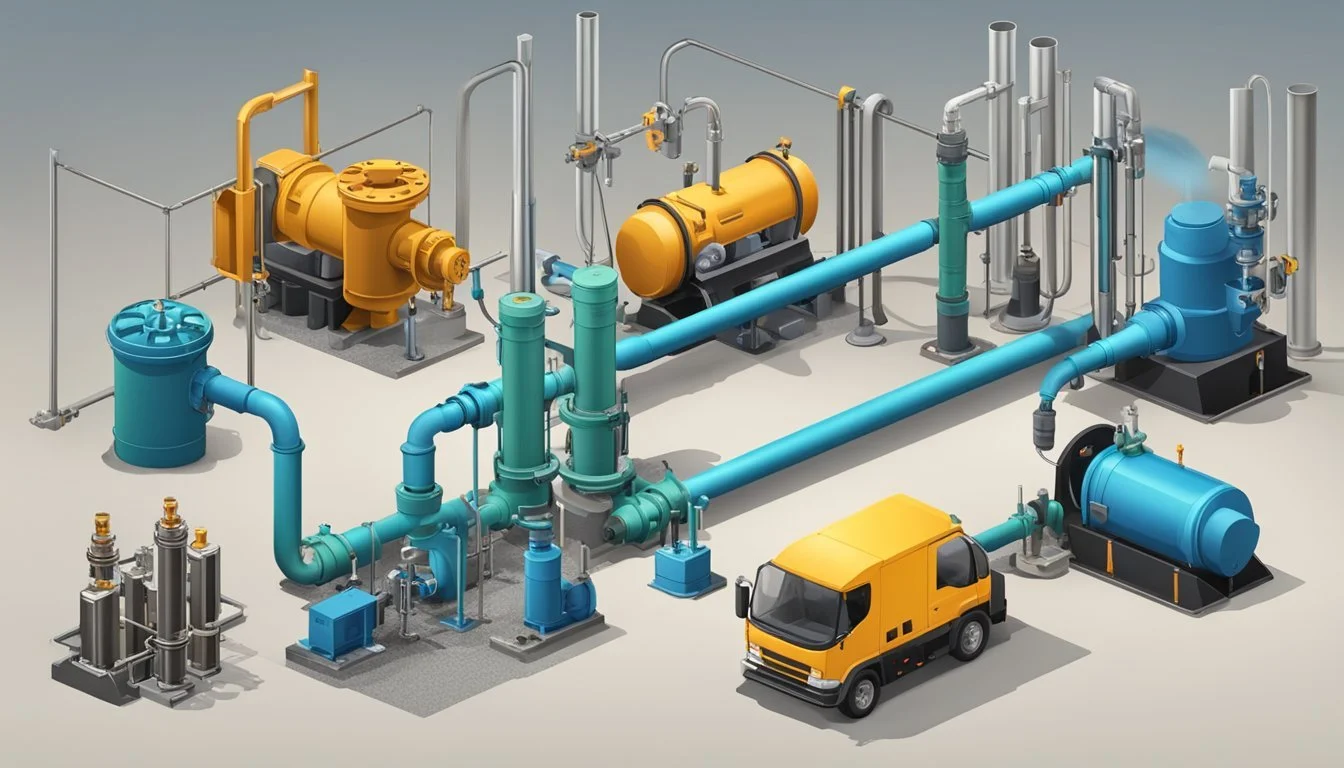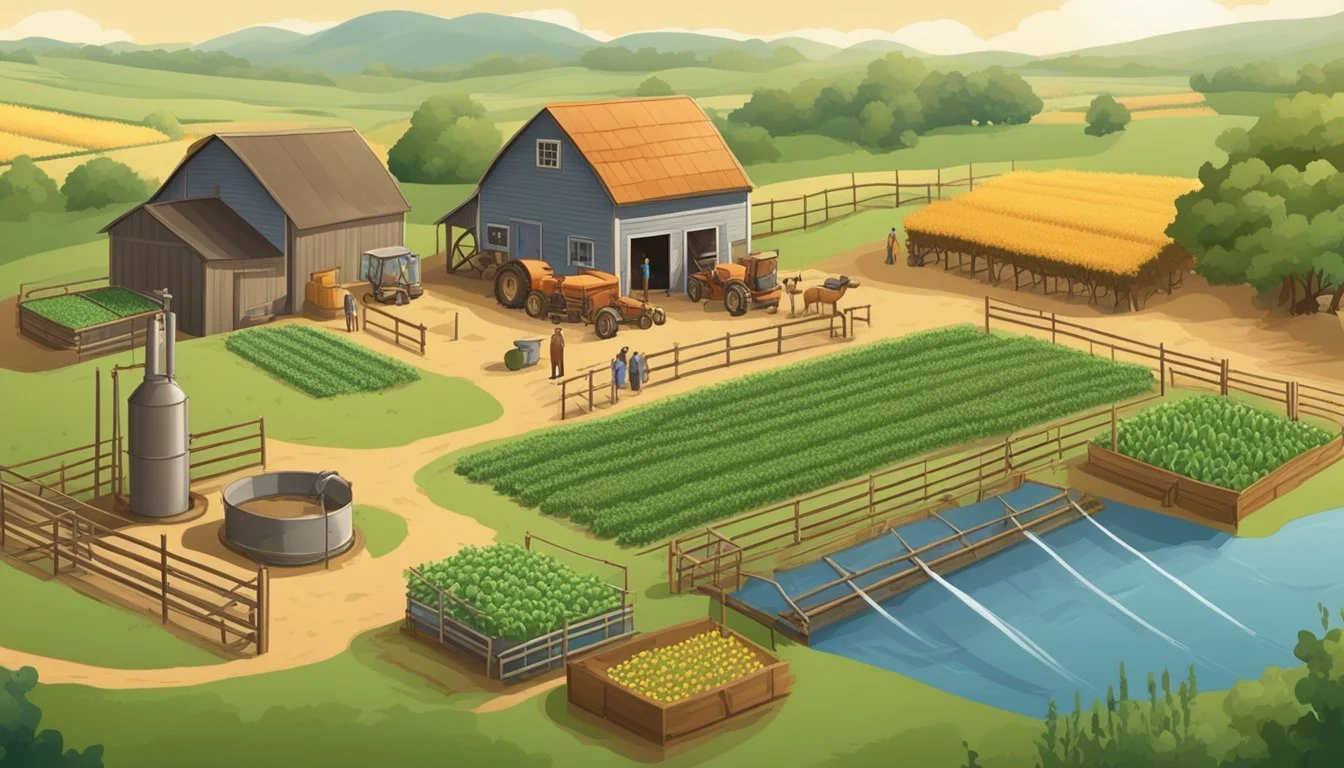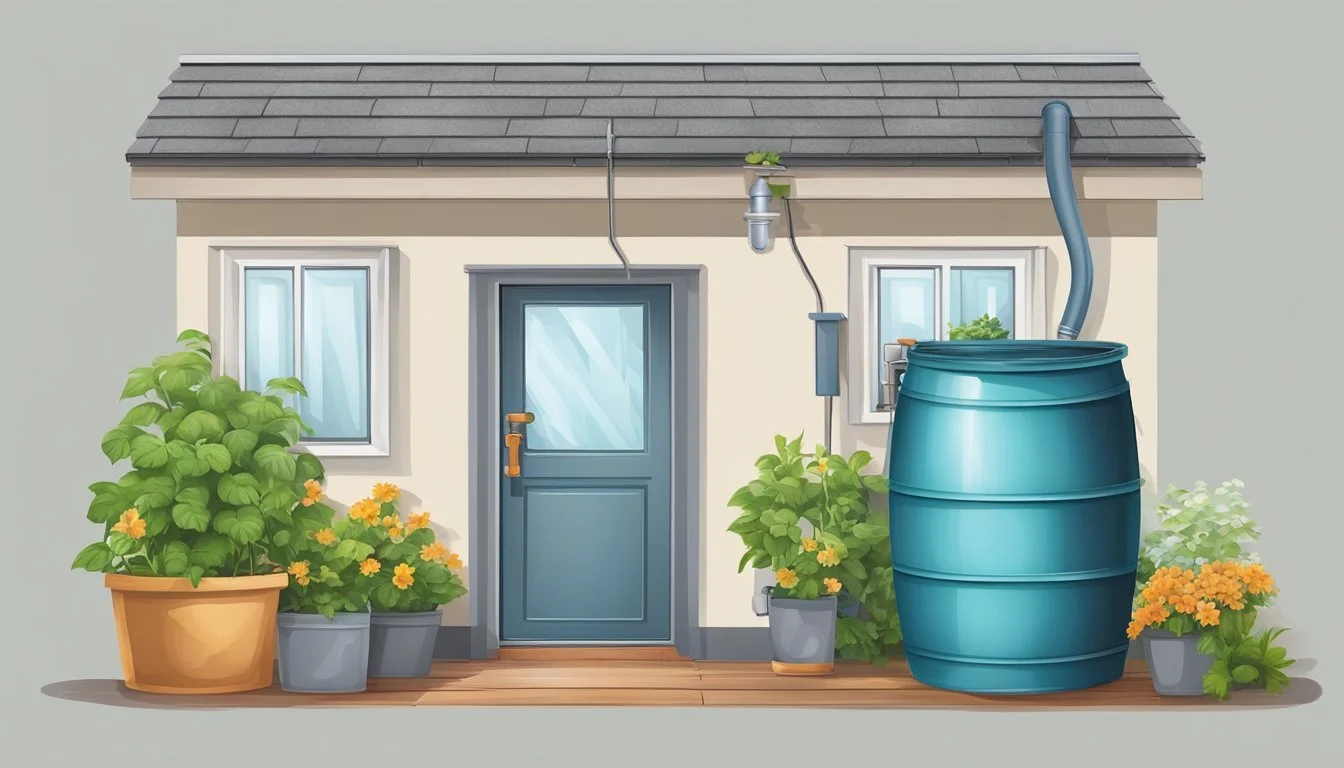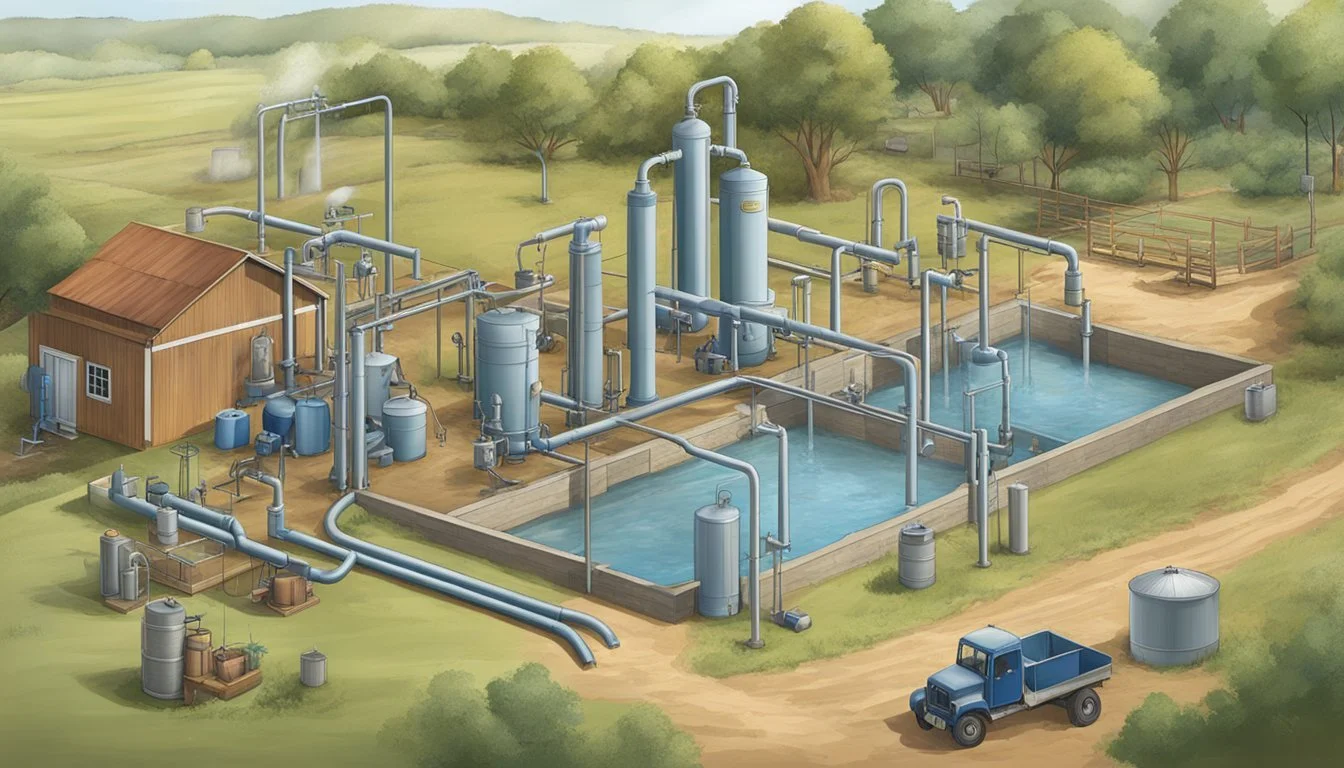Homestead Water Systems
Efficient Solutions for Self-Sufficient Living
Homestead water systems play a crucial role in the success and sustainability of off-grid living. As more people choose a self-sufficient lifestyle, it is important to understand the different options available and their advantages. Ensuring a reliable, safe, and efficient water source is paramount for those embracing homesteading.
One popular choice for homestead water systems is rainwater harvesting, which involves collecting, storing, and treating rainwater for domestic use. This approach promotes sustainability, reduces dependence on external water sources, and can even save money on utility bills. Other systems include wells, springs, and cisterns, each presenting its unique capabilities dependent on the specific requirements and geographic location of the homestead.
When considering which homestead water system to implement, factors such as water quality, availability, and maintenance must be taken into account. Thorough research, planning, and consultation with experts will ensure that the chosen system meets the needs of the homestead and contributes to a long-lasting, self-sufficient lifestyle.
It's important to assess the piece of land to identify natural water sources and determine the water levels. City water may be available as a reliable source, but rainwater collection and gravity-fed water systems could also be primary sources to consider for providing water for drinking and daily use, such as determining the gallons per day needed for the household. Additionally, evaluating the efficiency of the shower head can help optimize water usage.
Assessing Homestead Water Resources
Identifying Water Sources
For a successful homestead, it is essential to identify and choose the most appropriate water resources. Some common sources of water include:
Groundwater: Wells are drilled into the ground to access the underground water stored in aquifers.
Springs: Natural springs are areas where groundwater emerges at the surface, providing a consistent water supply.
Surface water: This includes lakes, streams, and other bodies of water that can be accessed directly.
Rainfall: Collecting and storing rainwater can be an effective supplementary water source, especially in areas with high precipitation rates.
Knowing the different types of water sources available on your homestead allows you to evaluate their potential use and choose the most suitable options for your needs.
Evaluating Water Availability and Quality
Availability and quality of water can significantly impact the success of your homestead. Consider the following when evaluating these parameters:
Seasonal variations: Surface water and rainfall levels can vary greatly due to seasonality. Research the typical fluctuations in your area to better predict water supply throughout the year.
Well yield: The flow rate or yield of a well must be considered to determine if it can provide sufficient water for the desired purpose.
Water quality: Ensure that water sources are free of harmful contaminants, such as chemicals, bacteria, and other pollutants. Regular testing and monitoring can help maintain the water quality.
Here's a list of water sources with information on their availability and quality:
Water Source: Well
Availability: High
Quality: Varies
Water Source: Spring
Availability: Moderate
Quality: Good
Water Source: Surface Water
Availability: Varies
Quality: Varies
Water Source: Rainfall
Availability: Seasonal
Quality: Good
Water Source Protection and Management
Proper protection and management of water sources are crucial to preserving their quality and sustaining your homestead. Some key practices include:
Wellhead protection: Regular inspection of wellheads and maintenance of the surrounding area can prevent contamination from entering the well.
Sediment control: For surface water sources like lakes and streams, reduce sediment and pollutant runoff by implementing erosion control measures, such as planting buffer strips or creating swales.
Rainwater collection systems: Design and maintain systems that efficiently collect and store rainwater. Keep surfaces and storage units clean to maintain water quality.
Implementing these strategies ensures that your homestead has a reliable supply of clean, safe water.
Setting Up Off-Grid Water Systems
Off-Grid Water System Components
When setting up an off-grid water system, it is essential to consider its components. A typical system includes:
Water source: This can be a well, spring, or a rainwater collection system.
Water pump: A pump is required to transport the water from the source to a storage tank or directly to the consumption points.
Water storage: A storage tank is necessary to store the water for later use. Storage tanks can be made from various materials, such as polyethylene, fiberglass, or stainless steel.
Water filtration: Including a filtration system ensures clean and safe drinking water.
Integrating Solar Power for Water Pumping
To increase self-sufficiency and save on energy costs, integrating solar power for water pumping is a valuable solution. Solar panels can be installed to generate electricity for pumping water from the source to the storage tank. A solar pump controller helps optimize the pump's performance when using solar energy.
Rainwater Harvesting and Storage Solutions
Rainwater harvesting is an effective way to supplement your off-grid water system. It involves collecting rainwater from various catchment surfaces, such as rooftops, and directing it to a storage tank. To set up a rainwater harvesting system, follow these steps:
Install gutters and downspouts: Ensure that your roof has proper gutters and downspouts to direct rainwater towards a collection point.
Install a first flush diverter: This device filters out debris, such as leaves and dust, during the initial rainfall, ensuring that clean water reaches the storage tank.
Connect a storage tank: Set up a water storage tank with an appropriate overflow system to collect and store rainwater.
Add a filtration system: Integrate a filtration system to treat harvested rainwater for potable or non-potable use, depending on your needs.
By following these guidelines and considering the mentioned components, setting up an off-grid water system can become a reality. Utilizing solar power for water pumping and implementing rainwater harvesting and storage solutions helps create a sustainable, self-reliant homestead.
Water Treatment and Purification
Water treatment and purification involve the process of removing impurities and contaminants from water to make it suitable for consumption and various other uses. This is essential to ensure the safety and health of individuals. When dealing with varying amounts of water, it's crucial to consider the natural water supply available, such as rainwater catchment, and the flow of rainwater. In some cases, an electrical pump may be necessary to facilitate the movement of water.
Additionally, factors such as the source of water, whether it's from a piece of land or city water, must be taken into account. Water treatment and purification methods can range from simple filtration systems to more complex processes, depending on the quality and intended use of the water. In some instances, a composting toilet may be considered a temporary solution to manage waste and preserve the flat surface for potential water collection.
Filtration Systems for Potable Water
Filtration systems play a crucial role in transforming raw water into potable water for homestead use. These systems work by eliminating various contaminants, enhancing water quality, and ensuring the water is safe for consumption. It's important to consider the amount of water per day needed for the household and select a filtration system that can meet this demand effectively. Several types of filters can be employed in a homestead setting:
Sediment Filters: These filters remove suspended particles, such as sand, silt, and rust from the water. They are commonly used as a pre-treatment step in the filtration process.
Activated Carbon Filters: They effectively remove chlorine, bad taste, and odor-causing contaminants. These filters also reduce volatile organic compounds (VOCs) and some heavy metals.
Ceramic Filters: Ceramic filters offer excellent filtration for bacteria and protozoan cysts, making them suitable for microbiological treatment.
Purification Techniques for Homesteaders
In addition to filtration systems, homesteaders should consider employing purification techniques to further ensure water safety. Several purification methods can be utilized to treat and disinfect water at a homestead:
Boiling: One of the simplest and most effective means of water purification, boiling kills bacteria, viruses, and protozoa that may be present in contaminated water. Bringing water to a rolling boil for at least one minute guarantees potable water.
Ultraviolet (UV) Treatment: UV radiation effectively destroys microbes, including bacteria, viruses, and protozoa. A UV treatment system can be installed after filtration to ensure the water is microbe-free.
Chemical Treatment: Chlorine and iodine are the most common chemical treatments for water purification. They inactivate microorganisms, rendering them harmless. However, ensure proper dosage to avoid imparting undesirable taste or odor to the water.
Implementing a comprehensive water treatment and purification system ensures that homesteaders enjoy safe and potable water. A combination of filtration and purification methods tailored to the specific water quality requirements of each homestead is advisable.
Water Pump Technology and Selection
A homestead water system is essential for both domestic and agricultural purposes. One of the crucial components of these systems is the water pump. This section will explore different types of pumps and technologies that are suitable for various homestead needs, focusing on manual and electric pump options, and solar-powered and wind-powered pumps.
Manual and Electric Pump Options
Manual Pumps are often a preferred choice for small-scale homesteads due to their simplicity, affordability, and low maintenance requirements. The most common manual pump is the hand pump, which can be used to extract water from shallow wells. Some advantages of hand pumps include:
No need for electricity
Easy to install and repair
Can draw water from depths up to 25-30 feet
Electric Pumps are suitable for larger homesteads with a continuous need for water and deeper wells. They are more powerful and capable of moving water greater distances than manual pumps. Different types of electric pumps are available in the market, such as:
Submersible well pump: Installed underwater within the well and can be used for depths up to 400 feet.
Jet pump: Installed above ground and can draw water from depths up to 150 feet.
Both types of pumps require a power source, and their energy efficiency may vary, making it essential to select the right pump for your homestead's needs.
Solar-powered and Wind-Powered Pumps
For those concerned about the environment and energy efficiency, renewable energy sources can be utilized to power water pumps.
Solar-powered pumps harness sunlight to generate electricity for running the pump. The main features of a solar-powered pump are:
Environmentally friendly
Cost-effective in the long run, especially in areas with abundant sunlight
Requires minimal maintenance
However, the upfront cost for solar-powered pumps may be relatively high due to the requirement for solar panels and a suitable positioning system for these panels.
Wind-powered pumps use the wind's energy to pump water mechanically or generate electricity to power an electric pump. These pumps offer several benefits, such as:
Sustainable and environmentally friendly
Well-suited for areas with strong wind patterns
Nevertheless, the unpredictability of wind patterns and the need to install wind turbines make this option less popular compared to solar-powered pumps.
Selecting the right water pump for a homestead depends on various factors, including the required pumping capacity, well depth, availability of power sources, and environmental considerations. By carefully evaluating these aspects, one can choose the most suitable pump technology for their water system.
Planning for Livestock and Agricultural Needs
Making sure your homestead has a sufficient water system is crucial for both livestock and agricultural needs. In this section, we'll look at the best practices for planning irrigation systems, general water requirements for different livestock, and how to ensure their overall well-being.
Irrigation and Watering Systems
Proper irrigation and watering systems are essential for the growth and maintenance of a healthy homestead. There are various systems to consider, depending on your specific needs and climate:
Drip irrigation: This method involves slowly releasing water near the roots of plants through a system of hoses, pipes, and emitters. It's a highly efficient way to water crops, as it minimizes water evaporation and waste. Drip irrigation systems are versatile and can be easily adjusted to cater to different plant types, water requirements, and environmental conditions.
Rainwater harvesting: Collecting rainwater in barrels or large tanks allows you to store water during times of surplus and redistribute it during droughts. Rainwater harvesting systems can be used in conjunction with other irrigation systems, adding an extra layer of water conservation for your homestead.
Sprinkler systems: These systems use water pressure to disperse water through a series of sprinklers over a larger area. They can be useful for certain agricultural applications but can also lead to higher water evaporation and waste if not managed properly.
When planning your irrigation and watering systems, consider factors such as the type of crops you're growing, the size of your land, the local climate, and the efficiency of the system. Conduct regular maintenance checks and replace parts as needed to ensure that your system remains effective and functional.
Water Requirements for Different Livestock
Different livestock species have varying water requirements for maintaining good health and productivity. Understanding these needs is vital for planning and implementing an efficient water system on your homestead. Here's a brief overview of the water needs for common livestock:
Livestock Species: Beef Cattle
Daily Water Requirement: 8 - 14 gallons
Livestock Species: Dairy Cattle
Daily Water Requirement: 15 - 25 gallons
Livestock Species: Swine
Daily Water Requirement: 3 - 6 gallons
Livestock Species: Goats and Sheep
Daily Water Requirement: 1 - 3 gallons
Livestock Species: Chickens, Ducks, and Geese
Daily Water Requirement: Individually unlimited
Keep in mind that these estimates may vary based on factors such as climate, diet, lactation status, growth rate, and activity level. Ensure you're constantly monitoring the water consumption of your livestock and make adjustments as needed. Additionally, provide clean and accessible water sources for all of your animals, as poor water quality can negatively impact their health and productivity.
Water Conservation and Management
Reducing Water Waste on the Homestead
Proper water conservation and management are crucial for a sustainable homestead. One significant step to reduce water waste is installing a greywater system. Greywater systems collect and treat water from sinks, showers, and washing machines, allowing it to be reused for irrigation or flushing toilets. By recycling water in this manner, homesteaders can effectively conserve water.
Another noteworthy method to reduce water waste is to fix any leaks in the plumbing system promptly. Even a small leak can waste thousands of gallons of water each year. Other simple but effective methods include:
Using a broom instead of a hose to clean driveways and sidewalks
Installing water-efficient appliances, such as low-flow showerheads and toilets
Watering plants during the cool hours of the day to minimize evaporation
Sustainable Practices for Water Use
Implementing sustainable practices is essential to manage water resources efficiently. One such practice involves installing rainwater harvesting systems to collect and store rainwater for future use. This water can be used for irrigation, reducing the dependence on external water sources.
Proper landscaping is another valuable sustainable practice, as it improves the overall water management of the homestead. Aim to use indigenous or drought-tolerant plants that require less water, and consider positioning plants with similar water needs together to optimize irrigation efficiency.
Moreover, implementing efficient irrigation techniques like drip irrigation or soaker hoses significantly reduces water loss. These methods deliver water directly to the plant's roots, minimizing evaporation and runoff.
In summary, integrating greywater systems, fixing leaks, using water-efficient appliances, harvesting rainwater, employing sustainable landscaping, and practicing efficient irrigation techniques contribute to effective water conservation and management on the homestead. By adopting these methods, homesteaders can maintain a more sustainable and self-sufficient lifestyle.
Infrastructure and Equipment for Water Systems
In a homestead water system, efficient infrastructure and equipment are vital for reliable water supply and management. In this section, we will discuss essential components for water systems, covering piping and plumbing essentials, along with crucial maintenance tools and supplies.
Piping and Plumbing Essentials
The foundation of any water system lies in its pipes and plumbing. Selecting the right materials and method of installation greatly influences the efficiency and effectiveness of water distribution.
PVC pipes: Polyvinyl chloride (PVC) pipes are widely used for their durability, affordability, and resistance to corrosion. They come in various sizes and pressure ratings, allowing for a flexible choice depending on the specific needs of the homestead.
Fittings and valves: Connecting pipes and controlling the water flow are vital tasks, usually accomplished by fittings, such as elbows, tees, and couplings, as well as valves. Gate valves, ball valves, and check valves are commonly used for smooth regulation and prevention of backflow.
Water storage: Above-ground or underground water storage tanks can be made from various materials like plastic, steel, or concrete. Proper insulation and filtration can prevent contamination and ensure a healthy water supply.
Pumps: Depending on the water source, different types of pumps, such as submersible, centrifugal, and diaphragm pumps, can be utilized for efficient water extraction and transportation.
Maintenance Tools and Supplies
Regular maintenance of the homestead water system is crucial for its longevity and smooth functioning. Here are some essential tools and supplies needed for efficient upkeep:
Pipe threading kit: To connect and customize pipes according to the required length, a pipe threading kit with various die sizes is essential for creating threaded ends on pipes.
Pipe cutter: Precision in cutting pipes is necessary for an effective plumbing system. Pipe cutters ensure clean and accurate cuts without leaving burrs on pipe edges.
Wrenches: Adjustable wrenches and pipe wrenches provide the required grip and torque to assemble and disassemble plumbing connections without causing damage to the pipes or fittings.
Plunger and plumbing snake: For clearing any blockages in the system, a plunger and plumbing snake become indispensable equipment to fix common clogs and ensure smooth water flow.
Teflon tape and pipe sealant: To prevent leaks and maintain proper pressure in the water system, Teflon tape and pipe sealant should be applied on threaded connections to create a watertight seal.
Investing in the right infrastructure and maintaining it with proper tools and supplies ensures the smooth functioning, durability, and reliability of a homestead water system. Keep these essentials in mind while building and maintaining your water system for a sustainable and efficient solution.
Dealing with Water-Related Challenges
Addressing Drought and Seasonal Variations
One of the primary challenges for homestead water systems is drought and seasonal variations in water supply. During times of drought or low rainfall, the water source may not provide a dependable supply. To ensure continuous access to water, homesteaders must plan and prepare for such situations.
An effective approach involves the diversification of water sources, through the integration of wells, rainwater harvesting systems, and water storage systems. Rainwater harvesting can mitigate seasonal water supply issues by collecting and storing water during the rainy seasons for use during drier months. Additionally, implementing water conservation strategies can optimize water use efficiency and reduce overall demand.
Key water conservation strategies include:
Use of low-flow fixtures and efficient appliances
Regular maintenance to prevent leaks
Water-efficient landscaping and irrigation
Safe Water in Emergency Scenarios
In situations where the normal water supply is compromised due to natural disasters or other disruptions, it is essential to ensure access to safe and clean water for personal and household use. Homesteaders can take several precautionary measures to ensure water supply reliability during emergencies:
Backup Water Supply: Maintain a backup water supply stored in food-grade containers. The recommended amount is one gallon per person per day for at least three days.
Water Purification: Equip the homestead with portable water filters, purification tablets, or other small-scale filtration methods that can be used when the regular water supply is contaminated or unavailable.
Alternative Water Sources: Identify alternative sources of water, such as nearby streams, springs, or lakes within the vicinity, which can be tapped with permission in emergency scenarios.
By addressing drought and seasonal variations alongside ensuring safe water in emergencies, homesteaders can develop a dependable water system that can withstand various challenges and provide a consistent and reliable supply of water for their everyday needs.
Designing an Efficient Water Distribution Network
Gravity-Fed Systems and Pressure
An essential aspect to consider when designing a homestead water system is efficiency. One popular approach to achieve this is through gravity-fed systems. These systems rely on gravity to create water pressure and distribute it throughout the property. A primary requirement for a gravity-fed system is the elevation difference between the water source and the delivery points. The greater the elevation difference, the more pressure the system can generate, providing an adequate water supply without the use of pumps.
To calculate the water pressure generated by the gravity-fed system, use the formula:
Water pressure (psi) = 0.433 × elevation difference (ft)Note: 1 psi (pound per square inch) is equivalent to 27.7 inches of water column.
Here's a brief example of how to apply this formula:
Elevation difference between water source and delivery point: 30 ft
Water pressure: 0.433 × 30 = 12.99 psi
A well-designed gravity-fed system should also include a storage tank to ensure consistent water delivery when demand peaks or water flow experiences interruptions. Installing pressure-reducing valves is recommended to control high pressure in specific areas where necessary and to protect plumbing fixtures.
Water Delivery to Different Areas of the Homestead
When designing an efficient distribution network, it's important to consider the varying water needs of different areas of the homestead. These can include:
Residential: Drinking, cooking, bathing, and laundry
Livestock: Drinking water and cleaning facilities
Garden or crop irrigation: Watering and nutrient application
Workshop or garage: Cleaning and equipment maintenance
It's crucial to establish separate zones for each of these areas and consider their unique requirements. For example, residential water use may require a filtration system, whereas garden or crop irrigation may only need untreated water. Properly allocating resources and planning the distribution network helps to avoid contamination and cross-connection between different areas, ensuring efficiency and safety throughout the system.
An efficient homestead water distribution network can be achieved through careful planning, a well-designed gravity-fed system, and the appropriate allocation of resources. By considering the various needs of different areas of your property and strategizing your infrastructure accordingly, you can create a water supply system that is both effective and sustainable.
Cisterns and Underground Water Storage
Types and Installation of Cisterns
Cisterns are large, durable containers designed to store water for household or agricultural use. They can be installed either above ground or underground depending on the specific requirements of the homestead. The main types of cistern materials include concrete, fiberglass, and polyethylene.
Concrete cisterns are known for their durability and longevity. They are often installed underground to avoid weathering and algae growth. These cisterns should be reinforced with steel to withstand soil pressure and ground movements.
Fiberglass cisterns are a lightweight and corrosion-resistant option. They can be installed above or underground, but they need to be protected against UV light when placed above ground. Installation requires a stable, well-draining base to support the cistern's weight.
Polyethylene cisterns are a popular choice for their affordability, lightweight nature, and corrosion resistance. They are suitable for both above and underground installation. When installing underground, it is essential to ensure proper backfill and compaction to prevent the cistern from collapsing under soil pressure.
Long-Term Water Storage Techniques
When storing water in cisterns or underground systems, it is crucial to maintain water quality for safe consumption or irrigation. Below are some techniques to enhance long-term water storage:
Filtration: Install a filtration system to remove contaminants such as sediment, bacteria, and algae, ensuring the water is safe to use.
Disinfection: Utilize methods such as chlorination or ultraviolet light treatments to eliminate pathogens from the stored water.
Cover: Ensure the cistern is well-covered to prevent direct sunlight exposure which can encourage algae growth.
Aeration: Introduce air into the water storage system to avoid stagnation and improve water quality.
Maintenance: Regularly inspect and clean the cistern to maintain water quality over time. This involves checking for cracks, leaks, and any signs of contamination.
Implementing a comprehensive water plan incorporating cisterns and underground water storage ensures a sustainable water supply for homesteads. By selecting the appropriate cistern type, installing it correctly, and utilizing long-term water storage techniques, homesteaders can access high-quality water throughout the year.
Budgeting for Homestead Water System
Cost-Effective Solutions for Water Infrastructure
When planning a homestead water system, it is essential to consider cost-effective solutions that maintain a balance between functional efficiency and budget constraints. The goal is to create a sustainable, off-grid water system while minimizing the overall cost. Here are some cost-effective alternatives to consider:
Rainwater Harvesting: Installing a rainwater collection system is a low-cost method of capturing and storing water. This can include using gutters, downspouts, and storage tanks or barrels.
Greywater Recycling: Reusing wastewater generated from household activities, such as doing laundry or washing dishes, can significantly reduce the demand for fresh water and lower your water bill.
Solar-powered Pumps: Investing in solar-powered pumps can be an economical choice for homestead water systems, as they offset the initial investment cost over time by not relying on grid electricity.
Allocating Resources for System Upgrades and Repairs
A crucial part of budgeting for a homestead water system involves allocating resources for timely system upgrades and repairs. Regular maintenance ensures the longevity and optimal functioning of the water infrastructure. Consider these steps when allocating resources:
Assess the system's lifespan: Understanding the expected lifespan of various components, such as pipes, pumps, and filters, can help you plan and budget for replacements or repairs.
Set aside a contingency fund: Allocate a portion of your homestead budget for unforeseen repairs or emergency replacement of equipment. This reserve will ensure that you are prepared for any unexpected breakdowns.
Evaluate repair vs. replacement: When faced with a malfunctioning item, weigh the costs of repair against the costs of replacement. In some cases, replacing a component may be a more cost-effective decision than making multiple repairs.
By considering cost-effective solutions and allocating resources for system upgrades and repairs, you can create a well-planned budget for your homestead water system. Keep these strategies in mind to ensure the long-term efficiency and cost-effectiveness of your off-grid water infrastructure.

